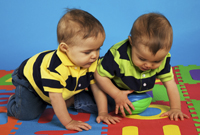Archived Content
The National Institute of Mental Health archives materials that are over 4 years old and no longer being updated. The content on this page is provided for historical reference purposes only and may not reflect current knowledge or information.
Balance Tips toward Environment as Heritability Ebbs in Autism?
Non-inherited Genetic Factors Also in the Mix -- NIH-funded Science
• Press Release

The largest and most rigorous twin study of its kind to date has found that shared environment influences susceptibility to autism more than previously thought.
The study, supported by the National Institutes of Health, found that shared environmental factors — experiences and exposures common to both twin individuals — accounted for 55 percent of strict autism and 58 percent of more broadly defined autism spectrum disorders (ASD). Genetic heritability accounted for 37 percent of autism and 38 percent of ASD. Random environmental factors not shared among twins play a much smaller role.
Earlier twin studies had estimated the genetic heritability of autism to be as high as 90 percent, due to much lower estimates of concordance — both members of a twin pair having the disorder — in fraternal twins. The new study found such concordance to be four to five times higher.
"High fraternal twin concordance relative to identical twin concordance underscores the importance of both the environment and moderate genetic heritability in predisposing for autism," explained Joachim Hallmayer, M.D., of Stanford University, Palo Alto, Calif. a grantee of the NIH's National Institute of Mental Health. "Both types of twin pairs are more often concordant than what would be expected from the frequency of autism in the general population. However, the high concordance among individuals who share only half their genes relative to those who share all of their genes implies a bigger role for shared environmental factors."
Hallmayer, senior co-investigator Neil Risch, Ph.D., of the University of California, San Francisco, and colleagues report on findings of the California Autism Twins Study (CATS) in the July 2011 issue of the Archives of General Psychiatry.
"These new findings are in line with other recent observations supporting both environmental and genetic contributions to ASD, with the environmental factors likely prenatal and the genetic factors highly complex and sometimes not inherited," said NIMH director Thomas R. Insel, M.D.
Studies are underway to determine if autism may be traceable, in part, to environmental exposures early during pregnancy.
The new study is the first to analyze a large sample of twins drawn from the general population; previous twin studies have been based on more limited samples, such as patients in treatment. It is also the first to employ the latest standard in diagnosing autism, which requires structured clinical assessments based on interviews with the parents as well as direct observation of the child.
Drawing upon state records, the researchers initially identified 1,156 twin pairs, with at least one member affected by an ASD, born to California mothers between 1987 and 2004. The children were all at least 4 years old, an age when autism can be reliably diagnosed. Ultimately, this group was winnowed to 192 twin pairs — 54 identical and 138 fraternal — for genetic analysis. Since autism disproportionately affects males, males outnumbered females by four to five times, with 80 of the pairs including both sexes.
Concordance for ASD was 77 percent among identical male pairs, and 31 percent among fraternal male pairs. In females, concordance for ASD was more closely spaced — 50% for identical and 36% for fraternal pairs. By contrast, previous studies had found concordance rates for fraternal twins that were much lower, ranging only in the single digits.
"Spectrum disorders traditionally thought to have less genetic loading turn out to stem from a similar mix of environmental and genetic heritability as narrowly defined autism," noted Thomas Lehner, Ph.D., chief of the NIMH Genomics Research Branch.
Yet, there can also be genetic influences that are not inherited from parents. New evidence emerged last month that rare, spontaneous mutations occur at abnormally high rates in autism.
"Such non-inherited genetic changes were proposed as a major mechanism of autism susceptibility, based on the very low concordance among fraternal twins found in earlier studies and evidence of increased risk associated with older parental age," explained Risch. "In light of the high fraternal twin concordance observed in our study, such new mutations may play a more limited role, since they would primarily occur in only one member of a fraternal pair, which would not lead to concordance."
Also participating in the research were investigators at: Autism Genetic Resource Exchange; California Department of Public Health; Kaiser Permanente; University of California, Davis. The research was also funded by Autism Speaks.
Reference
Genetic heritability and shared environmental factors among twin pairs with autism. Hallmayer J, Cleveland S, Torres A, Phillips J, Cohen B, Torigoe T, Miller J, Fedele A, Collins J, Smith K, Lotspeich L, Croen LA, Ozonoff S, Lajonchere C, Grether JK, Risch N. Archives of General Psychiatry. 2011 July.
About the National Institute of Mental Health (NIMH): The mission of the NIMH is to transform the understanding and treatment of mental illnesses through basic and clinical research, paving the way for prevention, recovery and cure. For more information, visit the NIMH website.
About the National Institutes of Health (NIH): NIH, the nation's medical research agency, includes 27 Institutes and Centers and is a component of the U.S. Department of Health and Human Services. NIH is the primary federal agency conducting and supporting basic, clinical, and translational medical research, and is investigating the causes, treatments, and cures for both common and rare diseases. For more information about NIH and its programs, visit the NIH website .
NIH…Turning Discovery Into Health®
